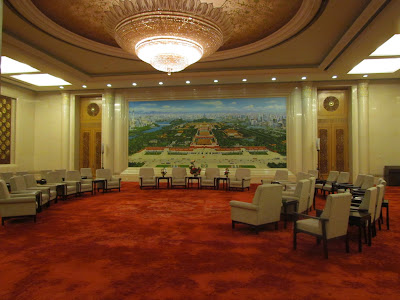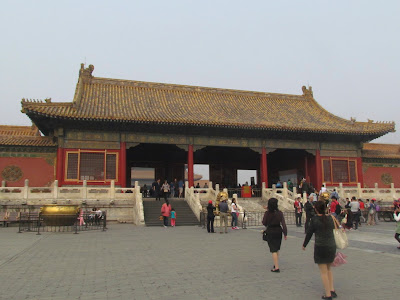BEIJING
TIANANMEN SQUARE AND THE FORBIDDEN CITY
Two of the most visited places in Beijing must be Tiananmen Square and the Forbidden City, now known as the Palace Museum, judging from the crowds we met there.
We started our day in Tiananmen Square which houses the Mao Zedong Mausoleum and the Great Hall of the People. We knew we had a busy day ahead so we agreed to take a pass on the mausoleum but it wasn't open to the public that day anyway.
We started our day in Tiananmen Square which houses the Mao Zedong Mausoleum and the Great Hall of the People. We knew we had a busy day ahead so we agreed to take a pass on the mausoleum but it wasn't open to the public that day anyway.
You can see a larger version of any
photograph by simply clicking the mouse once on the image. Another click
outside the image returns you to the text
The Mao Zedong Memorial Hall
A view across the Square on a hazy day, the Museum of Chinese History and the Museum of the Chinese Revolution in the background
We visited the Great Hall of the People. This is a very large building indeed, it
is 356 metres in length and 206.5 metres in width and 465 metres high
at its highest point. The Great Auditorium seats 3,693 in
the lower auditorium, 3,515 in the balcony, 2,518 in the gallery and
300 to 500 on the dais. It functions as the meeting place of the
National Peoples Congress, their Parliament. The Great Auditorium is
often seen on TV. Construction
was completed over a 10-month period in 1959, which is unbelievable if
you see the size of the building. There are at least 35 beautifully decorated meeting rooms. It turned out that the one thing we really wanted to see, the Great Auditorium, was closed. Again some of these other rooms are seen on TV when foreign dignitaries sit around making small talk.
The Sichuan Room
An impressive hallway
A decorative wall painting
The Shanghai Room
I think this is the one commonly used for the visit of foreign dignitaries
The Beijing Room
The Forbidden City is on the back wall
Monument to the People's Heroes
Flower decorations in the Square
An enormous basket of flowers
The
Forbidden City was the Chinese Imperial Palace from the Ming Dynasty
(1368–1644) to the end of the Qing Dynasty (1644 to 1912). It now
houses the Palace Museum. For almost 500 years, it served as the home of
emperors and their households, as well as the ceremonial and political
center of Chinese government. It was built over 14 years starting in
1406 and it required over 100,000 skilled artisans and 1 million
workers. It was called the Forbidden City because it was forbidden for commoners
or even uninvited nobility to enter its sacred precincts when the Emperors lived there.
Outside the Forbidden City - the Meridian Gate
The Gate of Supreme Harmony
One of the bronze lions - female because she is touching an infant lion with her claw
An Incense Burner
Hall of Supreme Harmony
A male bronze lion - stepping on a ball
Rear of the Hall of Supreme Harmony
Water vessels to fight fires
Stone carved slope
Another Incense Burner
Sundial outside the Hall of Supreme Harmony
And a tortoise
Detail of the roof
Bayonet marks made by soldiers trying to scratch the gold surface of the vat
A painted roof
The rear of the Hall of Supreme Harmony
The Hall of Middle Harmony
Inside the Hall of Middle Harmony
The Hall of Preserving Harmony
Inside the Hall of Preserving Harmony
Dragon Stone Carving
The Gate of Heavenly Purity
A gilt bronze lion (female) guarding the Palace of Heavenly Purity
The Palace of Earthly Tranquility
A really large incense burner in the Imperial Garden
Small Sitting Pavilion in the Imperial Garden
A tower on the corner of the moat - still hazy
The
Forbidden City is huge and we only saw a small fraction of the many
buildings. It would take far more than one day to cover it more
thoroughly.
For our evening meal we went to Serve the People, a Thai restaurant.







































No comments:
Post a Comment